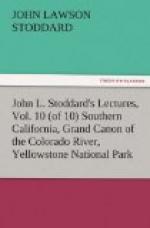[Illustration: WHERE THE SNAKES ARE KEPT.]
The religious element in all these ceremonies should not be lost sight of, for the life of the Pueblo Indians is permeated with religion, or superstition, to the minutest details. Thus, it is an interesting fact that vicarious atonement has been a custom among them from time immemorial, and their cacique is compelled to fast and do penance in many ways for the sins of his people. In some of the villages, also, certain men and women are chosen to expiate the wrongdoings of the tribe; and for more than a century there has been in New Mexico an order of Penitents, who torture themselves by beating their bodies with sharp cactus thorns, by carrying heavy crosses for great distances, and even by actual crucifixion. The severest of these cruel rites have, finally, been suppressed by the Roman Catholic church, but it encountered great difficulty in so doing, and the last crucifixion took place in 1891.
[Illustration: RELICS OF CLIFF DWELLERS.]
[Illustration: SUMMIT OF A MOQUI MESA.]
Such, then, are the Pueblos of New Mexico and Arizona; a race uniting aboriginal Pagan rites with Christian ceremonies: cherishing at the same time their idols and their churches; using to-day their rifles, and to-morrow their bows and arrows; pounding occasionally with a hammer, but preferably with a stone; and handling American money for certain purchases, while trading beads, shells, and turquoises for others. Sometimes we wonder that they have not made more progress during the centuries in which they have been associated with Europeans; but it is hard to realize the difficulties which they have encountered in trying to comprehend our civilization, and in grasping its improvements. Even the adoption of the antique Spanish plow, the clumsy two-wheeled cart, the heavy ax and the rude saw, which are still found among them, caused them to pass at one stride from the Stone to the Iron Age, which, but for the intervention of the Spaniards, they would not naturally have reached without centuries of patient plodding. Moreover, before the arrival of the Europeans, the Aborigines of America had never seen horses, cows, sheep, or dogs, and the turkey was the only domestic animal known to them. Hence, in ancient American society there was no such thing as a pastoral stage of development; and the absence of domestic animals from the western hemisphere is a very important reason why the progress of mankind in this part of the world was not more rapid. Still it is a remarkable fact that the most ancient race, of which we have any actual knowledge on this continent, is, also, the most peaceful, self-supporting, and industrious, subsisting principally on the sale of their curiously decorated pottery, and the products of their arid soil. We saw here a young man who had been educated in the Government School at Carlisle; but, like most of his race, after returning to his village he had reverted to the ways of his ancestors, disqualified by his birth and instincts of heredity from doing anything else successfully.




